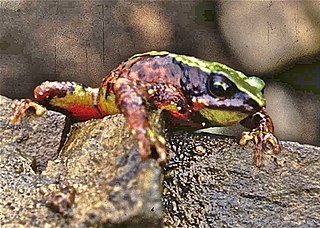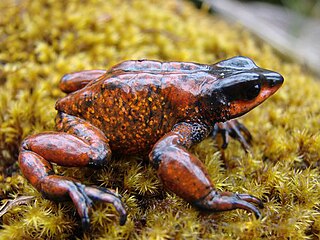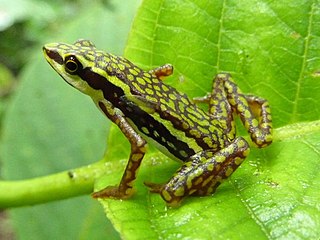
Atelopus is a large genus of true toads, commonly known as harlequin toads or stubfoot toads, from Central and South America, ranging as far north as Costa Rica and as far south as Bolivia. Atelopus species are small, generally brightly colored, and diurnal. Most species are associated with mid-to-high elevation streams. This genus has been greatly affected by amphibian declines, and many species are now considered endangered, while others already are extinct. While threatened by habitat loss, pollution, and introduced species, the primary cause of these declines appears to be the chytrid fungus Batrachochytrium dendrobatidis. For example, there are 32 known Atelopus species in Ecuador. One of these is data deficient, two are endangered and the remaining are critically endangered. Almost half the Ecuador species have not been recorded in a decade or more and are likely extinct. In some species conservationists have established captive colonies as a safeguard. However, numerous Atelopus species have been rediscovered decades after their last sighting, such as A. arsyescue, A. mindoensis, A. bomolochos, A. ignescens, A. balios, A. longirostris, A. subornatus and A. varius.

The starry night toad is a species of toad in the family Bufonidae endemic to the Sierra Nevada de Santa Marta, Colombia. Its natural habitats are sub-Andean and Andean forests, sub-páramo and páramo at 2,000–3,500 m (6,600–11,500 ft) above sea level. Reproduction takes place in fast-flowing rivers. It is named after its unique coloration, being largely black with white spots.

Atelopus arthuri, Arthur's stubfoot toad, is a species of toad in the family Bufonidae endemic to Ecuador. Its natural habitats are subtropical or tropical moist montane forests, subtropical or tropical high-altitude grasslands, and rivers. It is threatened by habitat loss. It has not been seen for more than 20 years and is considered probably extinct.

Atelopus balios, the Rio Pescado stubfoot toad, is a species of toad in the family Bufonidae. It is endemic to southwestern Ecuador, with records from Pacific lowlands in Azuay, Cañar, and Guayas Provinces. It is a rare species that was already suspected to be extinct, but a single specimen was discovered in 2011 by a team from Conservation International during a hunt for missing amphibians. The decline in amphibian populations is well documented. The Atelopus balios is Critically Endangered as a result of the widespread amphibian Chytridiomycosis fungus that has decimated other amphibian populations. There are only 10 known findings of the tadpole, Atelopus balios.

The Guajira stubfoot toad or Carrikeri harlequin frog, Atelopus carrikeri, is a species of toad in the family Bufonidae. It is about 5 cm (2.0 in) long and typically black, though some populations have orange coloration. This species is endemic to the Sierra Nevada de Santa Marta mountain range of northern Colombia. It is critically endangered because of the chytrid fungus, Batrachochytrium dendrobatidis, and habitat destruction due to agriculture. The species had not been seen from 1994 until it was rediscovered in early 2008.

Atelopus chiriquiensis, the Chiriqui harlequin frog or Lewis' stubfoot toad, is an extinct species of toad in the family Bufonidae that was found in the Cordillera de Talamanca in Costa Rica and western Panama. Its natural habitats were stream margins in lower montane wet forests and rainforests. Its elevational range was 1,400–2,500 m (4,600–8,200 ft) asl.

Atelopus coynei, the Rio Faisanes stubfoot toad, is a species of toad in the family Bufonidae endemic to Ecuador. Its natural habitats are subtropical or tropical moist lowland forests, subtropical or tropical moist montane forests, and rivers. It is threatened by habitat loss.

The elegant stubfoot toad or Pacific jambato frog is a species of toad in the family Bufonidae found in lowlands and Andean slopes of northwest Ecuador to 1,140 m (3,740 ft) asl and on the Gorgona Island, off southwest coast of Colombia. It was described by George Albert Boulenger in 1882 based on a specimen collected by Edward Whymper. It is known in Spanish as rana jambato del Pacífico or simply jambato del Pacífico.
Atelopus eusebianus, the Malvasa stubfoot toad, is a species of toad in the family Bufonidae endemic to Colombia. Its natural habitats are subtropical or tropical thigh-altitude grassland and rivers. It is threatened by habitat loss.

Atelopus franciscus, the Central Coast stubfoot toad, is a species of toad in the family Bufonidae, endemic to the central coastal region of French Guiana. It is a locally common, diurnal species found near fast-flowing small streams and creeks in lowland rainforest. Many authors have suggested this taxon might be a synonym of Atelopus flavescens. It is threatened by habitat loss.

Atelopus glyphus, the Pirri harlequin frog or Pirri Range stubfoot toad, is a species of toad in the family Bufonidae found in Colombia and Panama within the Northwestern Andean montane forests. Its natural habitats are subtropical or tropical moist montane forests and rivers.
The Guanujo stubfoot toad, known in Spanish as puca sapo, is a species of toads in the family Bufonidae endemic to Ecuador. Its natural habitats are subtropical or tropical moist montane forests and rivers. It is threatened by habitat loss.
Atelopus halihelos, the Morona-Santiago stubfoot toad, is a species of toad in the family Bufonidae endemic to Ecuador. Its natural habitats are subtropical or tropical moist montane forests and rivers. It is threatened by habitat loss.

Atelopus limosus, the limosa harlequin frog is an endangered species of toad in the family Bufonidae endemic to Panama. Its natural habitats are stream banks in tropical moist lowland forests and rivers of the Chagres watershed in central Panama.
Atelopus lynchi is a species of toad in the family Bufonidae. It is endemic to Ecuador. Its natural habitats are subtropical or tropical moist lowland forests, subtropical or tropical moist montane forests, and rivers. It is threatened by habitat loss.
The Mindo stubfoot toad or Mindo harlequin-toad is a species of toad in the family Bufonidae. It is endemic to Ecuador in Pichincha, Santo Domingo and Cotopaxi Provinces. Its natural habitats are subtropical or tropical moist lowland forests, subtropical or tropical moist montane forests, and rivers. It has a unique appearance and color pattern, being green and red with white speckles, and due to this it was once considered an emblematic species of the Mindo Valley.
Atelopus minutulus is a species of toad in the family Bufonidae. It is endemic to Colombia. Its natural habitats are subtropical or tropical moist montane forests and rivers. It is threatened by habitat loss.
Atelopus peruensis is a species of toad in the family Bufonidae. It is endemic to Peru. Its natural habitats are subtropical or tropical high-altitude grassland and rivers.
Atelopus sernai is a species of toad in the family Bufonidae. It is endemic to the northern Andes of Colombia. Its natural habitats include subtropical or tropical moist montane forests, subtropical or tropical high-altitude grassland, and rivers. It is threatened by habitat loss.
The Tamá harlequin frog or Venezuela stubfoot toad is a species of toad in the family Bufonidae. It is endemic to the Páramo de Tamá on the Venezuelan-Colombian border and occurs in Apure and (likely) Táchira states of Venezuela and Norte de Santander Department on the Cordillera Oriental of Colombia.











